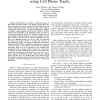Free Online Productivity Tools
i2Speak
i2Symbol
i2OCR
iTex2Img
iWeb2Print
iWeb2Shot
i2Type
iPdf2Split
iPdf2Merge
i2Bopomofo
i2Arabic
i2Style
i2Image
i2PDF
iLatex2Rtf
Sci2ools
CSE
2009
IEEE
2009
IEEE
A Language of Life: Characterizing People Using Cell Phone Tracks
—Mobile devices can produce continuous streams of data which are often specific to the person carrying them. We show that cell phone tracks from the MIT Reality dataset can be used to reliably characterize individual people. This is done by treating each person’s data as a separate language by building a standard n-gram language model for each “author.” We then compute the perplexities of an unlabelled sample as based on each person’s language model. The sample is assigned to the user yielding the lowest perplexity score. This technique achieves 85% accuracy and can also be used for clustering. We also show how language models can also be used for predicting movement and propose metrics to measure the accuracy of the predictions. Finally, we develop an alternative method for identifying individuals by counting the subsequences in a sample which are unique to their authors. This is done by building a generalized suffix tree of the training set and counting each subsequence f...
Computer Science And Engineering | CSE 2009 | Language Models | N-gram Language Model | Person’s Language Model |
| Added | 20 May 2010 |
| Updated | 20 May 2010 |
| Type | Conference |
| Year | 2009 |
| Where | CSE |
| Authors | Alexy Khrabrov, George Cybenko |
Comments (0)

